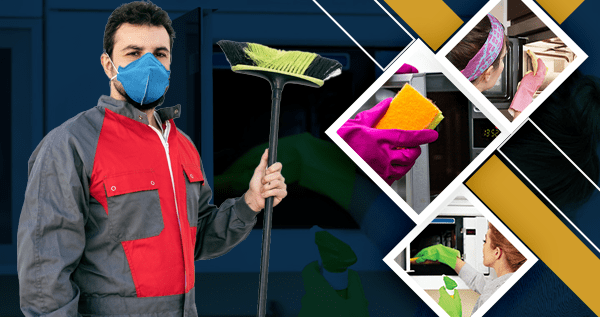The Dos and Don’ts of Cleaning Hard-to-Reach Areas
Keeping our living spaces clean and tidy is essential for a healthy and comfortable environment. However, there are often areas in our homes and offices that are difficult to reach and clean properly. These hard-to-reach areas can easily become breeding grounds for dust, dirt, and grime if neglected. In this article, we will discuss the dos and don’ts of cleaning those tricky spots to ensure your space stays sparkling clean.
The Importance of Cleaning Hard-to-Reach Areas
Before delving into the dos and don’ts, it is crucial to understand why cleaning those hard-to-reach areas is essential. Here are a few reasons why it is important to pay attention to these neglected spots:
- Prevent the accumulation of dust and dirt: Hard-to-reach areas tend to accumulate dust, dirt, and debris over time. Regular cleaning can prevent the buildup and keep your space clean and hygienic.
- Reduce the risk of allergies and respiratory issues: Dust and allergens are often found in hard-to-reach spots. By regularly cleaning these areas, you can minimize the risk of allergies and respiratory issues for you and your family.
- Improve the overall appearance: A clean and well-maintained space looks more appealing. By cleaning those forgotten nooks and crannies, you can enhance the overall aesthetic appeal of your living or workspace.
Dos:
1. Use Vacuum Attachments:
One of the most effective ways to clean hard-to-reach areas is by using vacuum attachments. Most vacuum cleaners come with specific attachments designed to clean tight spots, corners, and crevices. Attachments such as crevice tools, dusting brushes, and upholstery brushes can help you reach and clean areas that are otherwise inaccessible.
2. Utilize Extension Wands:
In areas with high ceilings or tall furniture, extension wands are a lifesaver. These lightweight and extendable poles allow you to reach high shelves, ceiling corners, and ceiling fans without the need for a ladder. Make sure to use a microfiber cloth or brush attachment at the end of the extension wand for effective dusting.
3. Invest in Long-Handled Tools:
Long-handled tools like dusters, brooms, and mops can be incredibly useful when cleaning hard-to-reach spots. They allow you to clean under furniture, behind appliances, and on top of cabinets without straining your back or bending too much. Opt for extendable handles to achieve the desired length for better reach and maneuverability.
4. Use Cleaning Solutions:
To tackle stubborn grease or grime in hard-to-reach areas, it’s crucial to use appropriate cleaning solutions. Consider using mild cleaners or natural solutions to avoid damaging surfaces. Always follow the manufacturer’s instructions and test a small, inconspicuous area before applying the solution to the entire surface.
5. Work from Top to Bottom:
When cleaning hard-to-reach areas, it is advisable to start from the top and work your way down. This way, any dust or debris that falls during the cleaning process will be captured and removed when you clean the lower areas. Start by dusting high surfaces and shelves, then move on to lower surfaces, floors, and baseboards.
Don’ts:
1. Don’t Overlook Ventilation:
Ventilation ducts and exhaust fans are commonly overlooked when it comes to cleaning hard-to-reach areas. However, neglecting these spots can lead to poor air quality and reduced efficiency. Regularly clean and remove dust buildup from air vents and exhaust fans using a soft brush or vacuum attachment.
2. Avoid Excessive Force:
While it’s tempting to scrub vigorously to remove stubborn stains or grime, it is important to avoid using excessive force, especially on delicate surfaces. Scrubbing too hard can cause scratches or damage the surface you are trying to clean. Always use gentle strokes and let the cleaning solution do its job.
3. Don’t Forget Light Fixtures:
Light fixtures and chandeliers can add a touch of elegance to any space. However, they can become dusty and grimy over time if not properly cleaned. Use a soft microfiber cloth or a feather duster to remove dust from light fixtures. If the fixtures are removable, wash them with mild soapy water, rinse, and dry thoroughly before reattaching.
4. Avoid Clutter:
A cluttered space not only makes cleaning more challenging but also creates more hard-to-reach areas. Keep your living or workspace organized and free from unnecessary clutter. Regularly declutter and remove items that are not needed to make cleaning easier and more efficient.
5. Don’t Forget Ceiling Corners:
Ceiling corners are often overlooked during routine cleaning sessions. However, they can accumulate cobwebs, dust, and even insects. Use a long-handled duster or a vacuum attachment to reach and remove any dirt or cobwebs from the corners. Regularly tackling ceiling corners will help maintain a clean and fresh space.
Conclusion
Keeping those hard-to-reach areas clean is crucial for maintaining a healthy and aesthetically pleasing living or workspace. By following the dos and avoiding the don’ts mentioned in this article, you can effectively clean these areas without risking damage or injury. If you find it challenging to clean these spots on your own, consider seeking professional cleaning services from a reliable company like Crystal Facilities Management. With their expertise and specialized equipment, they can ensure all the nooks and crannies of your space are thoroughly cleaned, leaving it spotless and hygienic.













